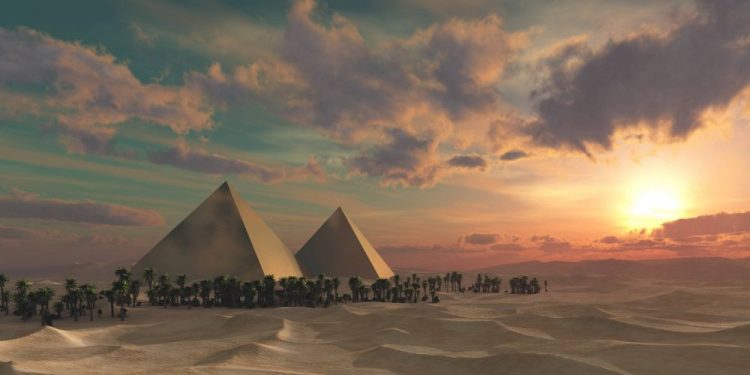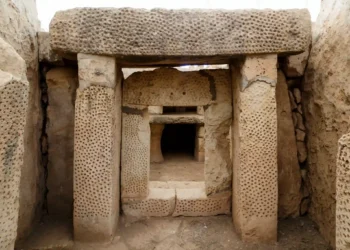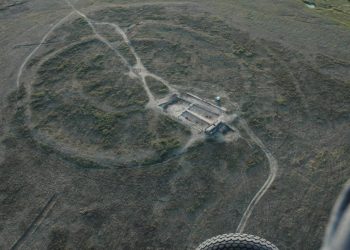Around 2,700 BC, ancient Egyptian building techniques were reborn. From complex mastabas where Pharaohs and royalty were buried, the ancient Egyptians developed Pyramids, which changed the ancient civilization forever. Although the ancient Egyptian civilization was not the first ancient culture to build pyramids, the pyramids of Egypt are certainly the most famous of all.
Earliest structures
The earliest pyramidal structures—not pyramids—called Ziggurats were built in ancient Mesopotamia much sooner than the Pyramids of Egypt. It has been argued by scholars that it where Ziggurats which influenced later civilizations like Egypt to build pyramids. The Ziggurats were important and would be painted brightly in gold and bronze.
Although equally imposing, ziggurats were different from Pyramids mostly because they were built of sun-dried mudbrick, unlike the Egyptian monuments, which were made of stone. And that is precisely why only a few ziggurats remain standing today, while stone-built pyramids are found worldwide, still standing after thousands of years. The earliest ziggurats began near the end of the Early Dynastic Period, and the latest Mesopotamian ziggurats date from the 6th century BC. The Ziggurats were created in receding tiers upon a rectangular or square platform. Their top was flat.
The Egyptian “rock” pyramids
Egyptian pyramids were different. Built out of rock, the ancient Egyptian civilization would eventually erect monuments that became the world’s largest constructions. The Egyptian pyramids would reach for the sky. They were covered in highly polished, reflective limestone, which made the pyramids reflect the sun’s rays, almost like a mirror. Their capstone was usually made of granite or basalt and was most likely plated with gold or silver, making the entire monument shine like a star in the night.
Starting around 2,700 BC, the ancient Egyptians continued building pyramids for a thousand years until 1,700 BC. The Egyptian sun god Ra acknowledged as the father of all pharaohs, was said to have created himself from a pyramid-shaped mound of earth before creating all other gods.
Pyramid of Djoser
The first Pyramid built by the ancient Egyptians was the Pyramid of Djoser, also known as the Step Pyramid. Located in the Saqqara necropolis in Egypt, the Step Pyramid is widely recognized as Egypt’s earliest monumental stone building. Commissioned in the 27th century BC, the Pyramid was envisioned as the eternal burial place of Pharaoh Djoser. Djoser’s royal vizier Imhotep, the first pyramid builder, built the Pyramid.
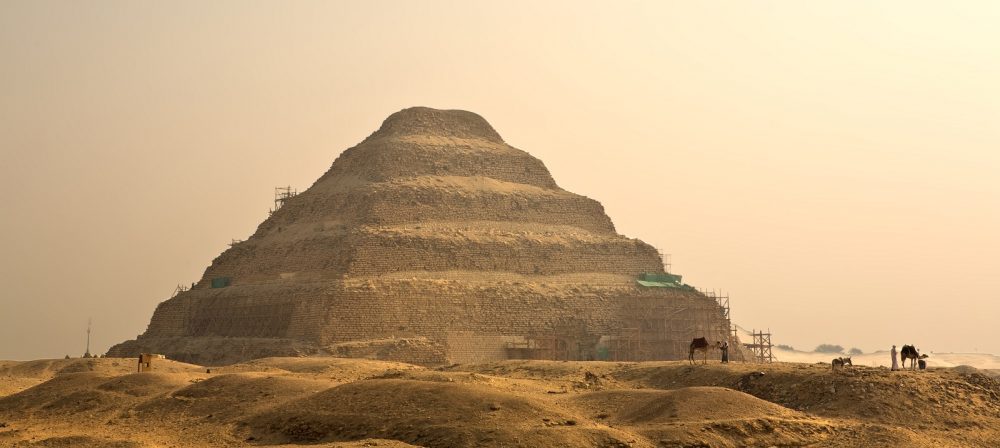
Imhotep created a unique tomb for the Pharaoh, which is perhaps why the Pyramid went through several revisions and redesigned, which steered away from the original plan. The Step pyramid once stood 62.5 meters (205 ft) tall, with a base of 109 m × 121 m (358 ft × 397 ft), and was clad in polished white limestone.
The original idea of a step pyramid was drawn from several precedents, the most relevant of which was the Saqqara Mastaba 3038, built circa 2700 BC. This structure was almost a pyramid by accident. It was built in a deep rectangular pit with mudbricks walls six meters in height. The three sides of the mastabas were extended and built out, creating eight steps that rise into the air at an angle of 49 degrees. Had the remaining side not been uncovered, this structure may have become the first elongated step pyramid.
Imhotep would eventually combine six mastaba-like structures into one, resulting in the steps we see today in Djoser’s Pyramid.
What started off as a complex mastaba, featuring some of the most amazing stones ever quarried to date, was remodified and expanded until it was turned into a staircase to the heavens, one that Pharaoh Djoser would walk in his afterlife, in order to meet Ra. —Pyramidomania; a World of Pyramids, Ivan Petricevic.
Djoser’s Step Pyramid was built with a total of 330,400 cubic meters. It was constructed between 2667–2648 BC and is the first Pyramid built in ancient Egypt.
Pyramid at Meidum
Although not famous, the Pyramid of Meidum is ancient Egypt’s second attempt at building a pyramid and the first attempt at building a straight-sided pyramid. The Pyramid was probably “built” between 2600 and 2589 BC.
Located around 100 kilometers from Giza, the Pyramid of Meidum was probably intended for Pharaoh Huni, although Sneferu finished it. But the Pyramid at Meidum was not successful, and Egyptologists argue that it already collapsed in ancient times. Imhotep’s successor was the man in charge of the construction process. But, unfortunately, he wasn’t as triumphant as the original pyramid architect.
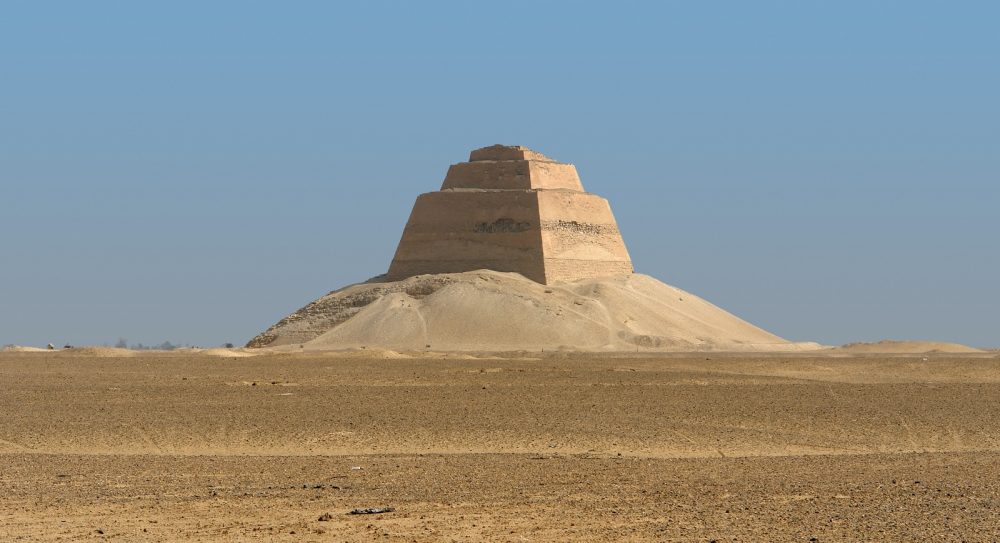
The structure most likely collapsed due to cardinal construction mistakes and the fact that the architect in charge made various modifications to Imhotep’s original design. There is also conclusive evidence that the Pyramid at Meidum was extended at least two times during construction. The second extension is that which may have turned the Pyramid from a step pyramid into a true pyramid. The builders were told to fill the Pyramid’s steps using limestone encasing. Their plan failed and proved catastrophic.
The Pyramid eventually collapsed mostly because the inner step pyramid was designed and envisioned as the final stage of the structure. Therefore, additional material only compromised the stability of the structure. It has been argued that the collapse of this Pyramid is one of the main reasons why Sneferu’s second Pyramid, the Bent Pyramid, was built with an angle of 43 instead of 54 degrees.
The Bent Pyramid
The Bent Pyramid of Sneferu, located in the necropolis of Dashur, is a unique example of early pyramid development in Egypt. The Pyramid is usually believed to have been completed around 2,600 BC. It is the third Pyramid built in ancient Egypt.
The Pyramid is characterized by the fact that it rises from the ground at a 54-degree angle. Still, its upper section, above 43 meters, was changed and built at a much shallower angle of 43 degrees, precisely what gives the Pyramid its notorious bent shape. With a total volume of 1,237,040 cubic meters, the Bent Pyramid has a total height of 104.71 meters.
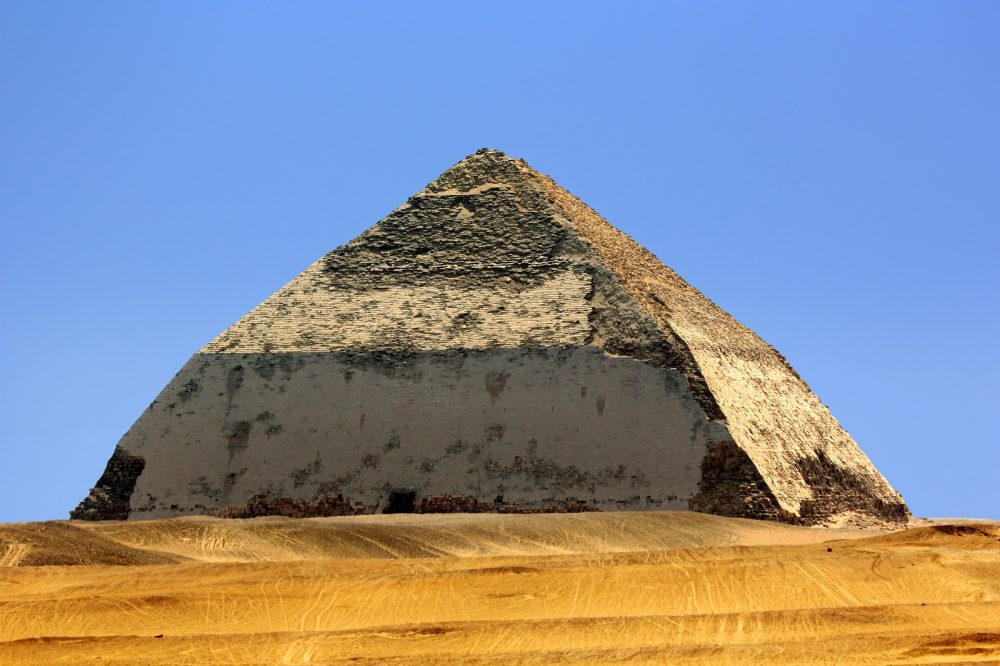
The reason why the Pyramid was bent may have something to do with the stability of the structure. It has been suggested that although the pyramid builders started the structure at a 54-degree angle, they were forced to reduce the angle because the Pyramid developed instability signs. Therefore, to not repeat the mistakes the builders at Meidum made, the constructors of the Bent Pyramid were forced to adopt a much shallower angle.
Evidence of that can be found near the Red Pyramid, built immediately after the Bent Pyramid. The Red Pyramid was initially built having an angle of 43 degrees. The Bent Pyramid is also unique because of all pyramids in Egypt. The Bent Pyramid’s outer limestone casing remains largely intact. The Bent Pyramid would lay the foundations of future pyramid buildings in Egypt and gave rise to the construction of the Red Pyramid, also built by Sneferu. The Red Pyramid would eventually lead to the construction of the most imposing Pyramid of ancient Egypt, the Great Pyramid of Giza.
Have something to add? Visit Curiosmos on Facebook. Join the discussion in our mobile Telegram group.



